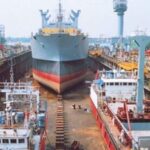Across the sector, there’s a push to reduce production costs per tonne of cement. Some industry players believe the outcome of this cost race could ultimately determine the survivors.
“The focus has shifted from pricing to cost and volumes. In a way, cost could be the decider on who survives the market competition,” said Ritesh Shah, head of mid-market research coverage and ESG at Investec, a financial services firm.
The shift comes as rising demand fails to prevent declining prices, with fierce competition driving down the industry’s earnings before interest, tax, depreciation, and amortization (Ebitda) per tonne from over ₹1,200 in FY21 to roughly ₹750 in recent quarters.
Read this | Is India’s cement sector finally turning a corner?
For the cement industry, two of the biggest costs are energy and logistics. Production is highly energy-intensive, requiring substantial coal and electricity inputs, while logistics costs weigh heavily due to the commodity’s bulk. Together, they make up 60-70% of total costs for cement makers.
Race to cut production costs
Cement makers are looking to save an average of ₹200 per tonne, according to analysts.
Leading this cost-cutting drive is the Adani Group, which has intensified competition since entering the market two years ago. Adani aims to reduce costs by an ambitious ₹530 per tonne by FY28, leveraging synergies across its energy, logistics, and resource trading arms to become India’s lowest-cost cement producer.
By the end of the September quarter, the group achieved approximately ₹250 per tonne in cost reductions, according to chief financial officer Vinod Bahety.
With manufacturing facilities under Ambuja Cements, ACC, Sanghi Industries, and Penna Cement—and soon Orient Cement after a pending acquisition—Adani has quickly become India’s second-largest cement maker, with a capacity of about 97 million tonnes per annum (mtpa).
Read this | Mint Explainer: What a consolidation in the cement industry means for smaller players, consumers
The Aditya Birla Group’s UltraTech, India’s largest cement producer, is on track to reach 157 mtpa by the year’s end, buoyed by recent acquisitions of Kesoram Industries and India Cements.
Energy efficiency takes centre stage
Energy costs are a key battleground for cement makers.
Adani Cement is aggressively pursuing a reduction in its energy costs through investments in waste heat recovery systems (WHRS) that convert waste gas heat into electricity.
“Our waste recovery capacity was 40 megawatts (MW) at the time of takeover, which we aim to expand to 218 MW by March 2025,” said Ajay Kapur, chief executive, Adani Cement, on a recent analyst call.
Adani is also targeting around 1 gigawatt (GW) of renewable energy capacity to go live by FY26, a move that would enable the company to source 60% of its power from green energy. While the company hasn’t disclosed specific figures for these projects, the initiative underscores its commitment to cost-effective and sustainable energy sources.
Currently, Shree Cement leads the sector in green energy adoption, with 54-55% of its power needs met by renewables and a goal to increase this to 60%. UltraTech, the market leader by capacity, is also investing in green energy, though it trails Adani and Shree. UltraTech expects to cover 33% of its power requirements through WHRS and renewables by FY25, with plans to raise this to 51% by FY26, according to an investor presentation.
Beyond the efficiency gains from WHRS, renewable energy offers cost savings compared to grid power and brings price predictability for up to 25 years, unlike coal-based power, which fluctuates with market prices.
Adani is bidding for captive coal mines to secure more stable coal supplies and reduce reliance on the volatile open market to further reduce its fuel costs. “A higher share of coal from our captive mines, along with the option to purchase imported pet coke, will help lower our fuel costs,” Kapur added.
Logistics investments
In logistics, companies are focused on minimizing transportation costs per tonne, which has led to investments in strategically located grinding units that convert clinker into cement closer to market demand.
These specialized units grind clinker from larger integrated plants to produce the final product, with integrated facilities typically near limestone mines and grinding units closer to end markets.
Rail transport is another cost-effective choice over road. Adani Group, for instance, has purchased 11 railway rakes under the government’s General Purpose Wagon Investment Scheme to move clinker from main plants. The company has also ordered 26 specialized rakes to transport ash from its thermal power plants to cement units, further optimizing logistics.
In an interesting move, Adani plans to expand its fleet of ships through its December 2023 acquisition of Sanghi Industries to leverage ocean freight as a more cost-effective transport option. The company is in the process of placing orders for these ships.
“This is where the key differentiator will come,” said Investec’s Shah. “Investment in WHRS and renewable energy is something that is doable and everyone will do that over time.”
More here | Cement sector consolidation is good for shareholders. But what about consumers?
Rail and road transport cost upwards of ₹4 per tonne, while shipping reduces that expense to just ₹0.50, he noted. “The guy who optimizes on sea freight will get to rule the cost curve.”
UltraTech has long integrated shipping into its logistics strategy and maintains a captive fleet of 22 railway rakes. In 2023, it expanded to waterways, transporting raw materials from Paradeep in Odisha to its integrated cement unit in Amreli, Gujarat.
Meanwhile, Adani’s extensive port access—from Gujarat to Kerala and Andhra Pradesh through subsidiaries like Ambuja, Penna, and Sanghi—further strengthens its logistical advantage, according to Shah.
The plan involves Sanghi Cements utilizing waterways for logistics along the western coast, while Penna Cements will handle supply routes from Krishnapatnam in Andhra Pradesh to Cochin in Kerala.
Benefits offset in cost-cutting race
Analysts suggest that the aggressive cost-cutting moves across the cement industry are likely to cancel each other out. While companies are trimming expenses, the widespread reduction in production costs means that competitive benefits may be minimal.
However, those unable to keep pace with these cost reductions could find themselves vulnerable to buyouts as industry consolidation looms.
“If you look at it, it’s an industry-wide effort to suppress the cost curve. So nobody benefits as the entire industry’s cost is going down. Only those who can reduce their costs by more than ₹200 per tonne will benefit,” said Shah of Investec.
Larger players like UltraTech and Adani are better positioned to achieve meaningful cost reductions, according to Akash Gupta, director, Fitch Ratings.
“Costs at their recent acquisitions can be significantly reduced by tapping into the wider group’s capabilities,” Gupta said, adding that these companies’ stronger balance sheets enhance their capacity to invest in cost-saving initiatives.
Also read | This indicator shows why cement companies have a rough road ahead
Smaller cement makers, while at a disadvantage, are still positioned to compete given that they are “well entrenched in their markets with robust profitability and balance sheets,” Gupta noted. He added that larger players may also slow down on acquisitions to focus on valuations, providing an opportunity for smaller producers to sustain themselves.









